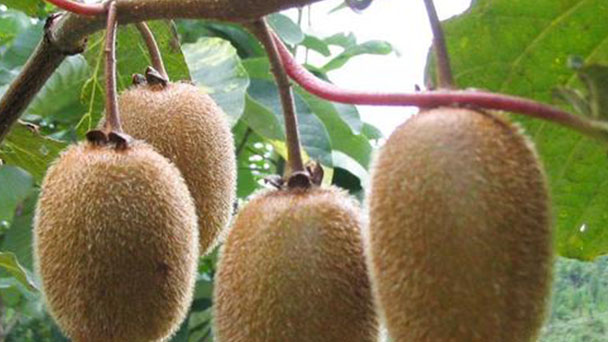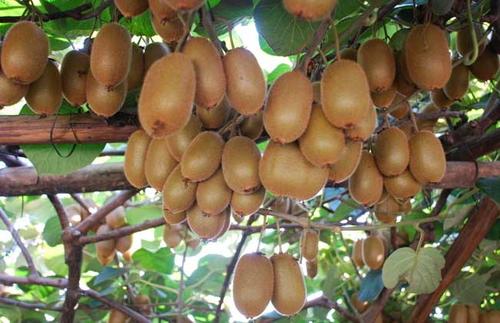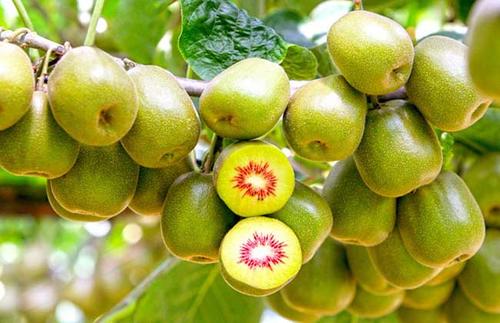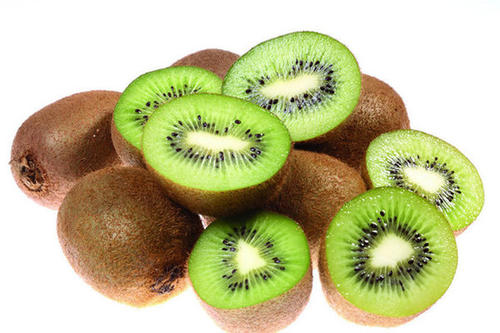Kiwi fruit profile
Written by Maggie
Feb 06 2021

Kiwi fruit, scientific name Actinidia chinensis Planch, is usually oval in shape, greenish-brown in appearance at early stage, and reddish-brown at maturity. Kiwi fruit skin is covered with dense downy, edible, bright green flesh and a row of black or red seeds.
Kiwi fruit picture

Morphological characteristics of kiwi fruit
Kiwi fruit is a dioecious large deciduous woody vine. The male plants are hairy and the leaves are small, and the male flowers appear earlier in the female flowers. The female plants are glabrous or glabrous, and the flowers and leaves are larger than the male plants.
Branch
Branches of Kiwi fruit are brown, pubescent, pith white, and lamellar.
Young branches or thick or thin with gray star-shaped hairs or brown long bristles or rust-colored bristles, bald when old or left with broken damage residual hairs; Flowers are 4 -- 5 cm short, 15 -- 20 cm long, 4 -- 6 mm in diameter; Alternate branches are completely bald glabrous, 5-8 mm in diam., lenticels oblong, relatively conspicuous or not so conspicuous, pith white to light brown, lamellar.
Leaf
Leaves of Kiwi fruit are for print, without stipule, broadly ovate to obovate or broadly ovate to suborbicular, 6 to 17 cm long, 7 to 15 cm wide, apex cut flat form and sunken into the middle or short acuminate, acute to acuminate, base obtuse round, flattened shape to shallow heart, margin vein out straight stretch of ciliary small tooth, the front variegated dark green, glabrous or midrib and lateral veins have a small amount of fur or scattered by short hair rough, and on the back of the pale green, densely covered with grayish white or light brown stellate hairs, lateral veins 5-8 pairs, often in the middle above divided into fork, lateral veins more developed, easy to see, the reticular small vein is not easy to see; Petiole of Kiwi fruit is 3-6(-10) cm long, covered with grayish velutinous hairs or russet bristles or rust-colored bristles.
Root
The distribution of Kiwi fruit root growth in the hard soil layer is shallow; Grows in loose soil distribution is deeper.
Kiwi fruit is fleshy root, and the root bark percentage is up to 30% ~ 50%. The root moisture content is high, the annual root water content is 84%, the biennial root water content is 79%, Kiwi fruit main roots are not developed, lateral roots and fibrous roots are developed. Kiwi fruit has a shallow and widespread root system. The thickness of active soil layer, temperature, moisture, air and nutrients are the main factors affecting root growth. In general, Kiwi fruit is most distributed in the soil layer with a depth of 40-80 cm. The distribution of the adult root population is about three times the size of the crown.
Roots Kiwi fruit has fewer backbone roots than ordinary fruit trees, but the roots have developed ducts, high root pressure, and strong regeneration ability after root injury. More than 50% of the total root length of adult Kiwi fruit is located in topsoil 30-50 cm deep, and more than 90% of the root length is within 1 m. Roots of young Kiwi fruit trees were bowl-shaped, and root length density decreased with depth and distance from the tree trunk.In adult trees, the density of root length decreased with depth, but was not affected by the distance from the trunk. Kiwi fruit has a longer root growth season than branches, with more than 30% of the root system being renewed each year.
Flowers
Flowers of Kiwi fruit are cymes 1-3 flowered, petioles 7 -- 15 mm, petioles 9 -- 15 mm; Bracts are small, ovate or subulate, ca. 1 mm long, all covered with grayish-white filamentous tomentose or yellowish-brown velus; The flowers are milky white when opening, then pale yellow, fragrant, 1.8-3.5 cm in diameter, solitary or several in leaf axils.
Kiwi fruit has 3-7 sepals, usually 5, broadly ovate to ovate-oblong, 6 -- 10 mm long, densely compressed yellow-brown tomentose on both surfaces; Kiwi fruit has 5 petals, sometimes as little as 3-4 or as many as 6-7, broadly obovate, with short claws; Stamens much, anthers yellow, oblong, 1.5-2 mm long, base forked or not forked, T-shaped; Ovary of Kiwi fruit is superior, globose, ca. 5 mm in diameter, densely golden compacted-interlaced tomentose or not compacted-non interlaced bristlelike hispid, style narrowly striate; Style is filiform, numerous.
The fruit
Fruit of Kiwi fruit is ovate oblong, cross - section radius of about 3 cm, densely yellow brown with branched villous.
Kiwi fruit is about the size of a duck egg (about 6 centimeters high and 4.5 to 5.5 centimeters in circumference), and is usually oval. Dark brown with hairy skin is generally not edible.Inside are bright green pulp and rows of black seeds.

Kiwi fruit growing methods
The temperature
Temperature is the main factor limiting the distribution and growth of Kiwi fruit. Each species has a suitable temperature range, beyond which it will fail to grow or survive. Most species of Kiwi fruit require warm and humid climate, namely subtropical or temperate humid and sub-humid climate, mainly distributed in the vast area of 18 ~ 34 degrees north latitude, the annual average temperature is about 11.3 ~ 16.9 ° C, extreme maximum temperature is 42.6 ° C, extreme minimum temperature is about 20.3 ° C, effective accumulated temperature above 10 ° C is 4500 ~ 5200 ° C, frost-free period is 160 ~ 270 days.
The temperature requirements of Kiwi fruit populations were not very consistent. For example, Chinese Kiwi fruit grew well in the annual average temperature range of 4 ~ 20℃, while delicious Kiwi fruit distributed most widely in the range of 13 ~ 18℃. Kiwi fruit growth phase is influenced by temperature, studies have shown that delicious Kiwi fruit when the temperature rise to about 10 ℃, germ bloomed, when more than 15 ℃ to blossom, more than 20 ℃ to the results, when the temperature dropped to 12 ℃ or so into the deciduous resting period, the whole development process takes about 210 ~ 240 days, the temperature can not less than 10 ~ 12 ℃ during the day.
Moisture
Kiwi fruit needs water but is afraid of waterlogging. Kiwi fruit is a fruit tree with weak physiological drought tolerance and moisture tolerance. Therefore, Kiwi fruit has strict requirements on soil moisture and air humidity, which determines that Kiwi fruit is the most suitable for cultivation in areas with abundant rainfall and uniform distribution, high air humidity, wet but not waterlogged. The annual precipitation in the natural distribution areas of Kiwi Fruit in China is 800 mm ~ 2200 mm, and the relative humidity of air is 74.3% ~ 85%.Generally speaking, the regions with annual precipitation of 1000mm ~ 2000mm and relative humidity of air around 80% can meet the water requirement of Kiwi fruit growth and development. If the average annual rainfall is 500 mm, it is necessary to consider setting up irrigation facilities for drought. High mountain areas are ideal for Kiwi fruit growth because of high fog, moist soil along streams and year-round humidity. In central and eastern regions, there is plenty of rain in spring, and the shoot growth is large, which is suitable for the growth of Kiwi fruit.
Kiwi fruit has large and dense leaves, high transpiration, and large demand for water. It is estimated that an adult Kiwi fruit tree with a canopy area of 25 square meters loses more than 75 liters of water per day through transpiration. Generally, when the soil moisture content is reduced to 5%-6%, the water shortage will result in the blocked shoot growth of Kiwi fruit, and its leaves will suffer from drought, sag of leaves will become smaller, and the leaf edge will wither. In the drought, the leaves begin to dry up, then must be timely irrigation or water, especially in the seedling stage, the root system has not been fully expanded, but also needs to supplement sufficient water. In addition to drought resistance, Kiwi fruit is also resistant to waterlogging, with about 40% of the plant dying after two to three days of poor drainage or waterlogging.In southern China's plum rain or northern rainy season, if continuous rain and poor drainage, the roots will be flooded, affecting root respiration, root tissue decay, and plant death. Therefore, deep furrow and high bed planting should be carried out when planting, and complete drainage and irrigation systems should be built in the orchard.
Light
Most Kiwi fruit species like semi-overshade environments, like sunshine but are sensitive to strong light irradiation. They belong to moderately light-loving fruit tree species, requiring sunshine time of 1300 -- 2600 hours, and are fond of diffuse light and avoid direct strong light. Results The plant required certain illumination, and the natural illumination intensity was 42-45%.
Soil
The soil for Kiwi fruit should be deep and fertile, with good air permeability, underground water level below 1 meter, high organic matter content, pH value 5.5-6.5 slightly acidic sandy soil, strong acid or alkaline soil should be improved and then cultivated.
In addition to soil quality and pH, mineral nutrients in the soil also have an important effect on the growth and development of Kiwi fruit. Since Kiwi fruit requires large amounts of nitrogen, phosphorus, potassium and abundant magnesium, manganese, zinc and iron, the lack of these minerals in the soil often leads to nutritional deficiencies on the leaves. Therefore, in order to ensure the normal growth and development of Kiwi fruit, it is necessary to improve the unideal soil by pumping, measuring the soil formula and fertilizing, burying a large amount of green manure and a certain amount of lime before planting in the garden.
The altitude
Kiwi fruit can be grown at 800-1800 meters, but at an altitude of 1000-1600 meters.
The main value of kiwi fruit
Ornamental value
Vines winding winding, thick branches and leaves, beautiful and fragrant flowers, suitable for flower shelf, courtyard, guardrail, wall and other vertical greening.
Healthcare value
Kiwi Fruit is a rich source of minerals, including calcium, phosphorus and iron. It also contains beta-carotene and multivitamins, which are important for maintaining good health.
Nutritional value
Known as the "King of Fruit", Kiwi Fruit is a sweet, sour and nutritious fruit for the elderly, children and the infirm and sick.

Latest Updated
- Benefits of Bugleweed - 7 Science-backed Health Benefits
- Bugleweed Dangers & Side Effects - Is It Poisonous?
- How to Plant Evergreen Trees - What You Should Know
- When to Plant Evergreens - Grow Guide for Evergreen Trees
- 12 Wonderful Evergreen Shrubs for Your Garden
- 12 Popular Evergreen Plants with Pictures for Beginners
- When And How To Prune A Lilac Bush Like a Pro
- How to Grow & Care for Lilac Vine (Hardenbergia Violacea)
- Japanese Lilac Tree (Syringa Reticulata) Care & Propagation Guide
- Shumard Oak Pros and Cons - What to Know
Popular Articles
- Winter maintenance of Antirrhinum Majus
- How to Grow Terminalia Mantaly Tree
- How to Grow and Care for Crossostephium Chinense
- How to grow Antirrhinum Majus in spring
- Peristeria Elata (Dove Orchid) Profile: Info & Care Guide
- Underwatered Snake Plant (Sansevieria Trifasciata) - Signs And How To Fix
- How to Care for Brazilian Jasmine Plant (Mandevilla Sanderi)
- How to Grow & Care for Graptopetalum Purple Delight in Summer
- Rosa Chinensis (China Rose): Plant Growing & Care Tips
- How to Care for Baby Sun Rose (Aptenia Cordifolia)